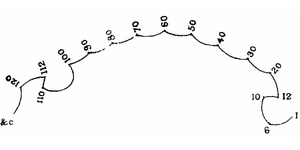Assessment |
Biopsychology |
Comparative |
Cognitive |
Developmental |
Language |
Individual differences |
Personality |
Philosophy |
Social |
Methods |
Statistics |
Clinical |
Educational |
Industrial |
Professional items |
World psychology |
Cognitive Psychology: Attention · Decision making · Learning · Judgement · Memory · Motivation · Perception · Reasoning · Thinking - Cognitive processes Cognition - Outline Index

A number form from one of Francis Galton's (1881b) subjects. Note the convolutions, and how the first 12 digits correspond to a clock face.
A number form is a mental map of numbers, which automatically and involuntarily appear whenever someone who experiences number-forms thinks of numbers. Number forms were first documented and named by Sir Francis Galton in his The Visions of Sane Persons (1881a). Later research has identified them as a type of synesthesia. In particular, it has been suggested that number-forms are a result of "cross-activation" between regions of the parietal lobe that are involved in numerical cognition and spatial cognition (Ramachandran and Hubbard, 2001; Hubbard et al., 2005).
Reaction time studies have shown that number-form synesthetes are faster to say which of two numbers is larger when the numbers are arranged in a manner consistent with their number-form, suggesting that number forms are automatically evoked (Sagiv et al., 2006; Piazza et al., 2006). This can be thought of as a "spatial Stroop" task, in which space is not relevant to the task, but which can hinder performance despite its irrelevance. The fact that synesthetes cannot ignore the spatial arrangement of the numbers on the screen demonstrates that numbers are automatically evoking spatial cues.
These number forms can be distinguished from the non-conscious mental number line that we all have by the fact that they are 1) conscious, 2) idiosyncractic (see image) and 3) stable across the lifespan. Although this form of synesthesia has not been as intensively studied as grapheme-color synesthesia, it seems reasonable to assume that similar neural mechanisms might be involved, but acting in different brain regions. Future studies will need to be conducted to test this hypothesis.
References
- Galton, F. (1881a). The Visions of Sane Persons
- Galton, F. (1881b) Visualised numerals. Journal of the Anthropological Institute, 10 85-102.
- Hubbard, E.M., Pinel, P., Piazza, M. & Dehaene, S. (2005). Interactions between numbers and space in parietal cortex. Nature Reviews Neuroscience, 6: 435-448.
- Piazza, M., Pinel, P. & Dehaene, S. (2006). Objective correlates of a peculiar subjective experience: a single-case study of number-form synaesthesia. Cognitive Neuropsychology, in press.
- Ramachandran, V. S. & Hubbard, E.M. (2001). Synaesthesia: A window into perception, thought and language. Journal of Consciousness Studies, 8(12), 3-34.
- Sagiv, N., Simner, J., Collins, J., Butterworth, B. & Ward, J. (2006). What is the relationship between synaesthesia and visuo-spatial number forms? Cognition, 101: 114-128.
| This page uses Creative Commons Licensed content from Wikipedia (view authors). |